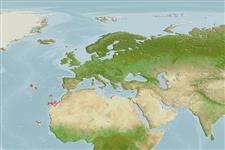Issue
Will eventually be assigned to a new genus.
Environment: milieu / climate zone / depth range / distribution range
Ecologia
marinhas associadas(os) a recifes; não migratória; intervalo de profundidade 0 - 25 m. Subtropical; 40°N - 13°N, 29°W - 11°W (Ref. 56021)
Eastern Atlantic: including Madeira, Azores, Ilheus Selvagens, Canary Islands, Cape Verde, and Senegal.
Tamanho / Peso / Idade
Maturity: Lm ? range ? - ? cm
Max length : 15.0 cm TL macho/indeterminado; (Ref. 27000)
Descrição suscinta
Chaves de identificação | Morfologia | Morfometria
Espinhos dorsais (total) : 13; Raios dorsais (total) : 16 - 17; Espinhos anais: 2; Raios anais : 13 - 14.
Adults inhabit rocky inshore areas, often near sand; juveniles found in tide pools. Food comprised mainly of algae with associated minute invertebrates (Ref. 6760). Males protect the eggs deposited in nests (Ref. 6760).
Ciclo de vida ou comportamento de acasalamento
Maturities | Reprodução | Spawnings | Egg(s) | Fecundities | Larvas
Oviparous, distinct pairing during breeding (Ref. 205). Eggs are demersal and adhere to the substrate (Ref. 205). Males protect the eggs deposited in nests (Ref. 6760).
Allen, G.R., 1991. Damselfishes of the world. Mergus Publishers, Melle, Germany. 271 p. (Ref. 7247)
Status na Lista Vermelha da UICN (Ref. 130435)
Ameaça para os humanos
Harmless
Uso pelos humanos
Ferramentas
Relatórios especiais
Baixar XML
Fontes da internet
Estimates based on models
Preferred temperature (Ref.
123201): 18.7 - 24.5, mean 20.2 °C (based on 85 cells).
Índice de diversidade filogenética (Ref.
82804): PD
50 = 0.7500 [Uniqueness, from 0.5 = low to 2.0 = high].
Bayesian length-weight: a=0.01259 (0.00490 - 0.03233), b=3.04 (2.82 - 3.26), in cm total length, based on LWR estimates for this (Sub)family-body shape (Ref.
93245).
Nível Trófico (Ref.
69278): 3.5 ±0.37 se; based on food items.
Resiliência (Ref.
120179): Elevada, tempo mínimo de duplicação da população menor que 15 meses (Preliminary K or Fecundity.).
Fishing Vulnerability (Ref.
59153): Low vulnerability (10 of 100).
Climate Vulnerability (Ref.
125649): High to very high vulnerability (71 of 100).
Nutrients (Ref.
124155): Calcium = 54.3 [24.9, 116.4] mg/100g; Iron = 0.693 [0.403, 1.170] mg/100g; Protein = 19.7 [18.7, 20.7] %; Omega3 = 0.234 [0.135, 0.397] g/100g; Selenium = 10.1 [4.9, 20.4] μg/100g; VitaminA = 85.5 [28.8, 262.9] μg/100g; Zinc = 1.07 [0.69, 1.62] mg/100g (wet weight);
